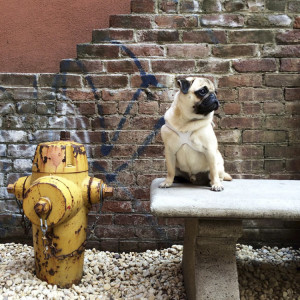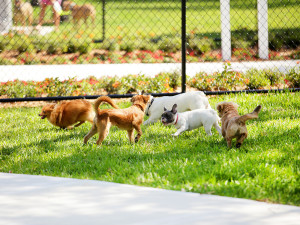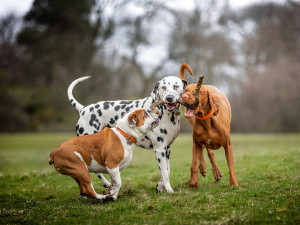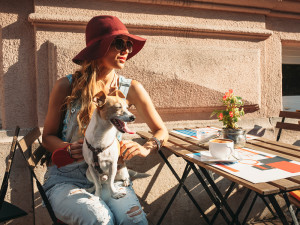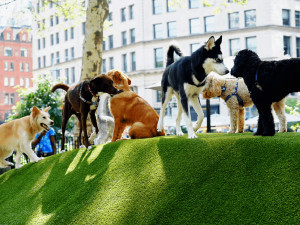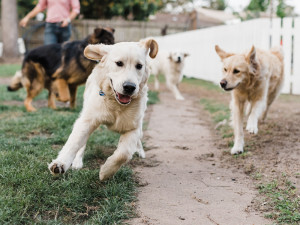Now You Can Rent a Private Dog Park Just For Your Dog
The dream for any pup parent, especially those with a reactive dog, thanks to Sniffspot.
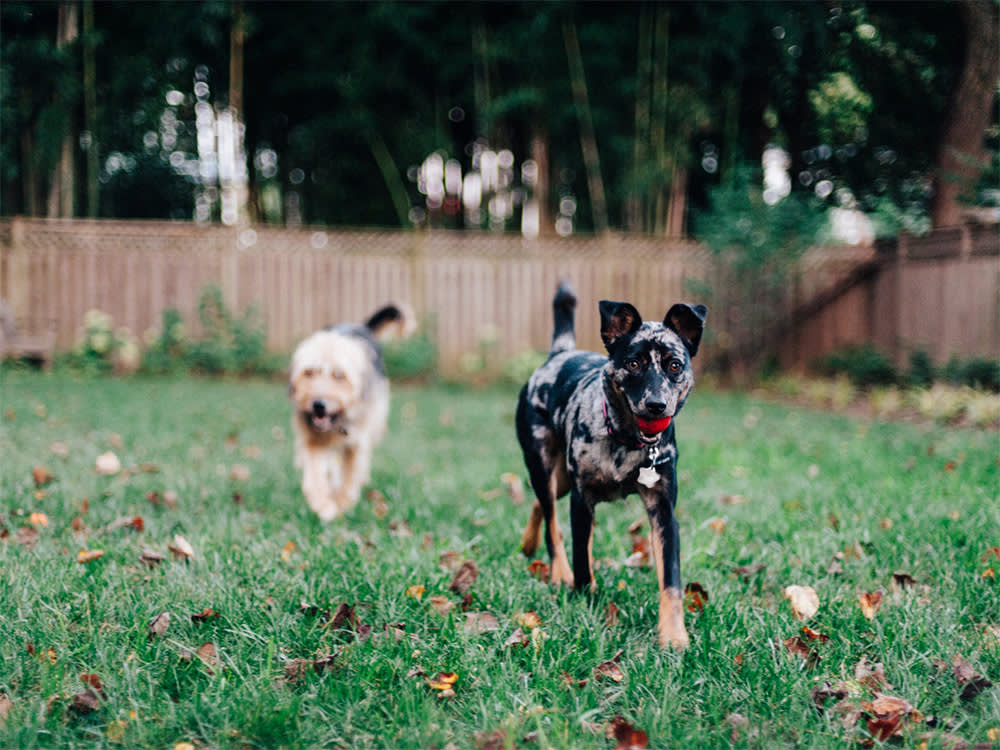
Share Article
The idea for Sniffspotopens in new tab came from a text. It was 2017, and David Adams’s then-girlfriend, now-wife, Rebecca, was traveling with her dog, Toshi, in Baltimore. While she was there, she texted Adams about how hard it was to take care of Toshi’s basic needs while they were traveling. “I wish there was an app where I could find places to let him off leash,” she told Adams then.
Adams, an entrepreneur in Seattle, was intrigued by the idea. He had adopted his own dog, Soba, in 2016, and knew how challenging it could be to find safe off-leash spaces for your dog when living in a big city. Adams posted in a local Seattle Facebook group, asking if other dog owners in the area were similarly struggling. The response was an overwhelming “yes.” So, Adams spent a couple of hours putting together a simple website and posted ads on Craigslist asking if anyone would be willing to open their yards for people’s dogs to play in. Hosts started offering up their yards, dog owners started signing up to visit them. Thus, Sniffspotopens in new tab was born.
How Sniffspot Evolved
Since it first launched in 2018, Sniffspot has had over 20,000 hosts sign up in 3,600 cities across the country, and the company averages about 25,000 bookings per month. For anywhere from $5 to $20 an hour, customers can book their own private dog park. This could be a host’s backyard; a vast, multi-acre field; or a space with water features like a pool or a pond — whatever kind of outdoor space your dog could desire, without the hassle of strangers or other dogs bothering them.
Each spot is reviewed by the Sniffspot team, Adams tells Kinship. While the company tries not to have too many specific requirements in order to attract hosts with a wide variety of spaces, for safety purposes, they review each potential spot on Google maps to ensure that it’s not next to a busy road or doesn’t have any obvious hazards on the site like an empty pool. The company also doesn’t allow other animals or people to be present during a visit.

As popular as the site is now, Adams says “it wasn’t an overnight success.” For the first nine or so months, Sniffspot was just a side project for him. But it kept steadily growing, and in 2019 he started working on it full time.
In many ways, Sniffspot hasn’t been exactly what he expected. “Originally, I thought that it would be something where people would want to make money,” he says. And while some hosts have capitalized on the opportunity to monetize their unused outdoor space (per Adams, some of the highest-earning hosts make $3,000 a month) he says the draw for most hosts is simply to make dogs happy.
“When we first started, nobody was making money on the app,” Adams says, laughing. “What I found was that Sniffspot really tapped into a community of dog lovers. The main value that hosts get out of Sniffspot is not necessarily the money. The money’s kind of like icing on the cake. It’s really about helping dogs.”
The Necessity of “Dog Disneylands”
Adams had also assumed that the most popular Sniffspots would be yards and other areas in cities that could cater to urban dog owners. Those kinds of spots are definitely popular, he says, but at least as popular among users have been large, multi-acre spaces outside of cities where dogs can run and romp. “Kind of dog Disneylands, so to speak,” he says.
Another peripheral — but welcome — result has been the chance for the company to help educate the public about dogs’ needs. One specific group that benefits from Sniffspot are dogs with reactivity issues, a segment of the canine population that Adams says has been “stigmatized and marginalized for a long time.”
“People are brought up with this stereotype of dogs as man’s best friend, and the happy-go-lucky Golden Retriever. And that’s not actually an accurate view of dogs,” Adams says. According to Adams, research has shown that up to 75 percent of dogs are in some way reactive, meaning they have outsized responses to certain stimuli, be it other dogs, people, sounds, etc. Because of this, crowded outdoor spaces, like public dog parks or busy city streets, can be overwhelming for certain dogs. Adams argues that not only is some degree of reactivity in dogs far more common than we think it is, but that “there’s ways for dogs with reactivity to have great lives.”
Even if your dog is the stereotypical, happy-go-lucky type, Adams says that providing time for them to be off-leash is invaluable for their well-being. “The way that dogs evolved and were bred was in open fields and forests,” he adds. “That’s what they’re designed for. And now they’re being kept on leashes and on couches. And that’s the basis of a lot of issues that dogs are having today, not just with reactivity, but also with obesity and anxiety.”
By letting your dog explore spaces off-leash, Adams continues, you allow them to do what they were born to do, and more importantly, sniff what they were born to sniff. “Dogs’ noses are super highly developed, and they can basically paint a picture with their nose,” he says. “And so for a dog, having the freedom to use their nose how they want is like having the freedom to look at whatever you want as a human. It’s very relaxing for a dog; it’s very enriching. And it’s interesting. It’s kind of like reading a novel with their nose.”
A Game Changer For Dog Parents
When pup parents take their dogs to a Sniffspot for the first time, Adams says the feedback the company gets is often so similar, it sounds like it came from a form letter. “We hear literally these same words again and again: ‘It brought tears to my eyes to see the look of joy on my dog’s face.’”
Given that every dog is different and has different needs, Adams recommends trying out different kinds of Sniffspots and seeing which ones your dog responds to most positively. Maybe they prefer a yard with agility equipment, or a wide open field, or a hill for climbing.
Whatever their preference is, Adams says he hopes more and more people and dogs will have more and more access to Sniffspots in the coming years. The company is continuing to grow, including internationally, and there are now Sniffspots in Canada, Australia, and New Zealand. “When we think of our mission and what we want to do, it’s about making the world a more dog friendly place.”

Madeleine Aggeler
Madeleine Aggeler is a freelance journalist and copywriter in Washington, D.C. Previously, she was a writer at New York magazine’s The Cut. She lives with her dog, Cleo, who works primarily as a foot warmer.
Related articles
![A pug sitting on a bench outside next to a fire hydrant.]()
6 Private Dog Parks for NYC’s Slobbery Social Elite
New York’s hottest clubs are members-only dog runs.
![A group of dogs running around in grass.]()
Create a Neighborhood Dog Park and Win Over All the Local Pups
The hottest club in your neighborhood is...the dog park.
Are Dog Parks Good for Socialization?
Help! Should I take my young dog to the dog park for “socialization”?
![Woman sitting in a cafe with her dog.]()
Can Your Shy New Rescue Dog Become a Social Creature?
With patience and positive reinforcement, you can do a lot to make up for lost time with socialization.
![dogs at dog park drinking water and playing in pool]()
Dog Park Etiquette: Dog Park Dos and Don’ts
New kid on the block? Follow this trainer’s tips before letting your pet run wild.
![Golden retriever dogs chasing each other through a yard in play.]()
The Unexpected False Advertising of Public Dog Parks
These apparent canine meccas can pose real risks to your dog’s overall safety.
How to Manage Leash Reactivity in Your Dog
If your pup acts diabolical on walks, you are not alone. Here’s what you can do.
